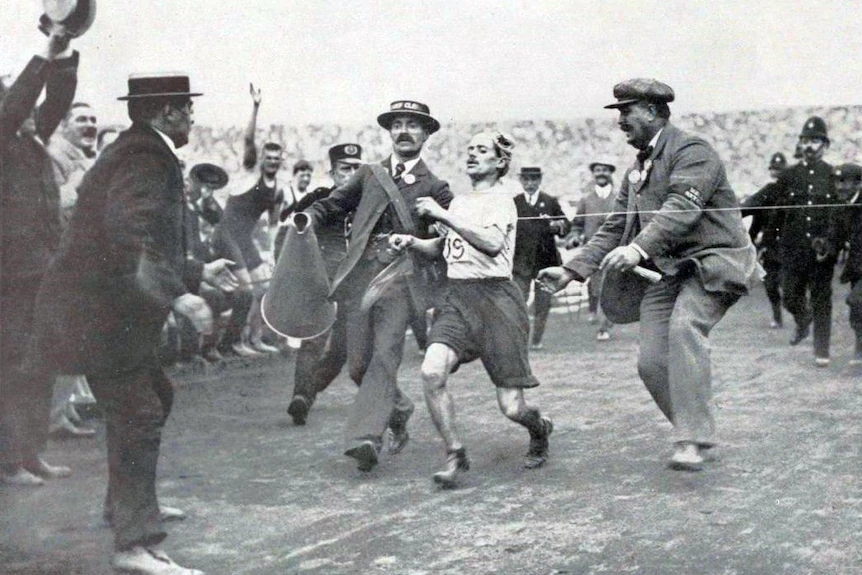Rat Poison, Cheating, Close Deaths, The Bonkers Story Of The 1904 Olympic Marathon In St. Louis
- Daniel Holland

- 11 hours ago
- 8 min read

When people think of the Olympic Games, they picture sleek stadiums, elite athletes, and international glory. What they probably don’t imagine is a dusty, chaotic marathon run through choking air, wild dogs chasing barefoot runners, a Cuban postman snatching peaches from passing cars, and a winner fuelled by brandy, egg whites, and rat poison. Yet this was precisely the spectacle that unfolded at the 1904 Olympics in St. Louis. It was America’s first time hosting the Games—and it very nearly became its last.
The event was supposed to celebrate a century of progress since the Louisiana Purchase, a grand union of sport and spectacle held alongside the Louisiana Purchase Exposition, better known as the St. Louis World’s Fair. The fair itself was a monumental display of American innovation and pride. But it was also steeped in imperialism, with exhibits designed to promote the supposed superiority of Western civilisation. The Olympics, absorbed into this environment, became less a celebration of athletic prowess and more a sideshow amid the fanfare of brass bands, Ferris wheels, and carnival barkers.
The French historian Pierre de Coubertin, who had revived the modern Olympics less than a decade earlier, later called the St. Louis Games a “disaster.” His dream of international unity through sport had been reduced to a provincial spectacle where nationalism trumped fair play, and where even the most serious events were treated as entertainment.

A Fair Overshadowing a Dream
The World’s Fair dominated every aspect of the 1904 Olympics. Visitors who came for the Games found themselves wandering past scientific demonstrations, mechanical wonders, and grotesque colonial exhibitions. The organisers had blurred the line between anthropology and show business. Nowhere was this more apparent than in the so-called “Anthropology Days,” during which organisers recruited men from the fair’s “ethnic villages”—including Indigenous Americans, Africans, and Filipinos—to compete in pseudo-athletic contests like greased-pole climbing, mud slinging, and “native dancing.” The intent, of course, was to amuse white spectators and reinforce stereotypes of “primitive” peoples.
Pierre de Coubertin, watching from afar, was horrified. “As for that outrageous charade,” he said, “it will of course lose its appeal when black men, red men and yellow men learn to run, jump and throw, and leave the white men behind them.” His words would prove prophetic.

The Marathon Begins
The marathon was meant to be the highlight of the Games, an homage to ancient Greece and a test of endurance worthy of legend. But what took place on 30 August 1904 in St. Louis was closer to a circus act than a competition. The race began at 3:03 p.m.—the hottest part of the day—with the temperature climbing above 90°F (32°C) and humidity so thick it seemed to cling to the lungs. The 24.85-mile course snaked across rutted country roads coated in dust, weaving between trolley tracks, railway crossings, and open countryside. Cars carrying officials and coaches followed the runners, throwing up thick clouds of dust that made breathing almost impossible. One race official later described the course as “the most difficult a human being was ever asked to run over.”

James E. Sullivan, chief organiser of the Games, believed that limiting access to water would make the event more “scientific.” He wanted to study the effects of dehydration, so runners were only allowed to drink at two points along the route—one at six miles, the other at twelve. It was a dangerous experiment that would leave several men hospitalised.

A Line-up of Characters
The starting line was filled with an assortment of athletes and adventurers. Among them were five experienced American marathoners: Sam Mellor, A.L. Newton, John Lordon, Michael Spring, and Thomas Hicks. They were joined by Frederick Lorz, a 19-year-old bricklayer who trained by running at night after long shifts at work. There was also Félix Carvajal, a diminutive Cuban mailman who had spent months running across his homeland to raise travel money, only to lose it all in a New Orleans gambling hall. Undeterred, he hitchhiked his way to St. Louis, arriving in tattered dress shoes, a long-sleeved shirt, and a beret. A fellow runner took pity on him and cut his trousers into makeshift shorts.
Ten Greek entrants arrived with little to no marathon experience, and two men from the Tswana tribe of South Africa appeared barefoot. They had been brought to the fair as part of an exhibit on the Boer War and had never run such a race before. Yet, as history would show, they would outlast many of their better-equipped competitors.
Into the Dust
When the starting pistol fired, the runners dashed into a choking cloud of dust. Within minutes, the heat and fumes took their toll. William Garcia of California collapsed on the roadside with severe haemorrhaging; the dust had torn his stomach lining. He was rushed to hospital and nearly died. Sam Mellor led briefly, but cramps forced him to stop. John Lordon vomited and gave up. Fred Lorz, overcome by exhaustion, decided to quit. But then, spotting one of the official cars, he climbed in and rode for eleven miles, waving at spectators along the way.
Meanwhile, the South African runner Len Taunyane was chased a mile off course by a pack of wild dogs. Félix Carvajal, on the other hand, seemed in good spirits. He jogged steadily, chatting with spectators in broken English, even pausing to steal a couple of peaches from a car when refused one politely. Later he stopped at an orchard and snacked on apples, which unfortunately turned out to be rotten. Doubled over with cramps, he lay down by the roadside and took a short nap before resuming the race.

Strychnine and Brandy
Thomas Hicks, one of the race favourites, was enduring his own ordeal. At the ten-mile mark he begged his trainers for water. They refused and instead sponged his mouth with warm distilled water. Seven miles from the finish, his support team prepared a concoction of egg whites mixed with a small dose of strychnine—a rat poison that, in tiny quantities, acts as a stimulant. This was the first recorded use of performance-enhancing drugs in Olympic history. They also carried French brandy, which they rationed carefully.

As Hicks staggered forward, the effects of the poison and heat took hold. His face turned ashen; his vision blurred. Yet when his trainers told him that Fred Lorz had been disqualified, he rallied and forced himself onward. They gave him another dose of strychnine, this time washed down with brandy. Hicks’s body was failing but his will was ferocious. One race official wrote that he ran “mechanically, like a well-oiled piece of machinery,” his knees stiff, his eyes vacant, his arms swinging heavily at his sides. He began hallucinating, at one point believing the finish line was still twenty miles away.
As he entered the stadium, Hicks tried to sprint but could not. His trainers, walking beside him, lifted him partially off the ground, carrying him over the finish line as his legs moved weakly beneath him. He had to be treated by four doctors before he could even speak. He had lost eight pounds during the race and later said, “Never in my life have I run such a tough course. The terrific hills simply tear a man to pieces.”

The Fake Victory
While Hicks was being revived, Fred Lorz—the man who had ridden in the car—crossed the finish line earlier and was initially hailed as the victor. The crowd roared as he entered the stadium. President Theodore Roosevelt’s daughter, Alice, placed a wreath on his head and was about to hand him the gold medal when someone shouted that Lorz had cheated. The cheers turned to jeers. Lorz smiled sheepishly and insisted that it had been “a joke,” but the Amateur Athletic Union banned him for life. The ban was later lifted when he apologised, and he went on to win the Boston Marathon the following year

Survival, Scandal and Lessons
Only fourteen of the thirty-two starters finished the race. Those who did staggered across the line in varying states of collapse. Len Taunyane, despite being chased off course by dogs, managed to come ninth. Félix Carvajal, after his ill-fated fruit feast, finished fourth. Thomas Hicks was declared the official winner—but only just.
James E. Sullivan, the man responsible for organising the event, later admitted that the experiment had gone too far. “A twenty-five mile run,” he told reporters, “is asking too much of human endurance… it is indefensible on any ground but historic.” He suggested that the marathon might be dropped from future Games.
That, of course, did not happen. Instead, the 1904 fiasco became a cautionary tale. When the next Olympics were held in London in 1908, organisers standardised the marathon distance at 26 miles and 385 yards, introduced more water stations, and implemented stricter rules about outside assistance. It was a direct response to the debacle in St. Louis.

The World’s Fair Legacy
The 1904 Olympics cannot be separated from the context of the World’s Fair that hosted them. The fair itself drew nearly twenty million visitors and presented a vision of American modernity. But it also mirrored the racial hierarchies and colonial thinking of its time. Anthropology Days, in particular, have become infamous as an early example of how science and spectacle were used to justify imperialism.
For the athletes who competed in the Games, it was a world in flux. The two Tswana runners were effectively participants in a colonial display rather than invited Olympians. Félix Carvajal, a working-class mailman, symbolised the rise of sport as something that could transcend class boundaries. And Thomas Hicks, with his dangerous mix of stimulants, marked the start of a conversation about ethics and endurance that would echo through Olympic history.
The Aftermath
For many of the runners, the 1904 marathon was life-changing. Hicks retired soon after, admitting that the experience had nearly killed him. Fred Lorz redeemed himself a year later. Félix Carvajal became a folk hero in Cuba and was later sponsored by his government to run in Athens in 1906. When he failed to appear, newspapers published his obituary. He surprised everyone when he returned to Havana months later, having simply taken longer to travel home.
The marathon itself survived, as did the Games. But the lessons of 1904 reshaped the Olympic movement. From that chaotic beginning grew the modern tradition we know today—one built on stricter organisation, fairness, and respect for the athlete’s welfare.

America’s Strangest Olympics
Looking back, it is hard not to see the 1904 Games as both a product and a parody of their time. They reflected a young nation trying to prove itself on the world stage, tangled in the contradictions of empire, innovation, and spectacle. What should have been a noble sporting celebration turned into a dust-choked endurance test that nearly destroyed the marathon as an Olympic event.
Yet from its absurdities came progress. The 1904 Olympics remain a fascinating chapter in history—a reminder that the road to greatness is often littered with mistakes, misjudgements, and, occasionally, wild dogs.
Sources
Smithsonian Magazine – “How the 1904 Marathon Became One of the Weirdest Olympic Events of All Time”https://www.smithsonianmag.com/history/how-the-1904-marathon-became-one-of-the-weirdest-olympic-events-of-all-time-14910747/
Olympics.com – “The Strange Case of the St. Louis 1904 Marathon”https://www.olympics.com/en/news/the-strange-case-of-the-st-louis-1904-marathon
Explore The Archive – “The Disastrous 1904 Olympic Marathon”https://explorethearchive.com/1904-olympic-marathon
Populous Magazine – “The Bizarre Tale of the 1904 St. Louis Marathon”https://populous.com/article/the-bizarre-tale-of-the-1904-st-louis-marathon
Marathon Handbook – “The Marathon from Hell: The 1904 St. Louis Olympics”https://marathonhandbook.com/the-marathon-from-hell/








































































































Comments